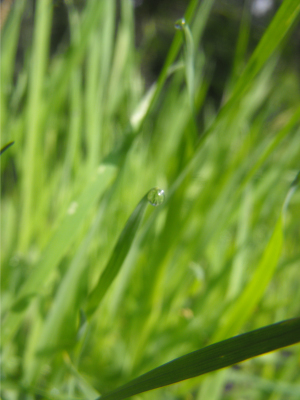
Oat cover crop
 Yes,
the pictures don't lie --- I've been planting grass in our
garden. Perhaps an eighth of our garden beds are currently
fallow, partly because I didn't water carefully enough and had a hard
time getting my fall
crops to
germinate. As August winds to a close, it's too late to replant
the turnips, cabbage, beets, and carrots that had spotty (or no)
germination. Instead, I can double up on greens and lettuce, plan
ahead for the fall garlic, and then fill all of the remaining beds with
cover crops to improve the soil.
Yes,
the pictures don't lie --- I've been planting grass in our
garden. Perhaps an eighth of our garden beds are currently
fallow, partly because I didn't water carefully enough and had a hard
time getting my fall
crops to
germinate. As August winds to a close, it's too late to replant
the turnips, cabbage, beets, and carrots that had spotty (or no)
germination. Instead, I can double up on greens and lettuce, plan
ahead for the fall garlic, and then fill all of the remaining beds with
cover crops to improve the soil.
As you'll recall, buckwheat has
been relegated to my list of cover crops that can't handle heavy clay
and high groundwater
--- the precise type of trouble spot I want to remedy with cover crop
planting. The next cover crop on my experimental list is oats,
and already this grain seems to be growing much more hardily than
buckwheat. Hopefully, the oats will be winter-killed in a couple
of months and will leave the beds happily mulched with straw of their
own making.
I had some hull-less
oat seeds leftover,
but not nearly enough to sow all of the beds I was hoping to turn
fallow for the rest of the summer. After looking at shipping
rates on the internet, I realized that cover crop seeds are best bought
locally. Our feed store had a 50 pound bag for about twelve
bucks, allowing me to plant as heavily as I pleased with plenty of the moderately
high protein grain
left to feed to the chickens.
Want more in-depth information? Browse through our books.
Or explore more posts by date or by subject.
About us: Anna Hess and Mark Hamilton spent over a decade living self-sufficiently in the mountains of Virginia before moving north to start over from scratch in the foothills of Ohio. They've experimented with permaculture, no-till gardening, trailersteading, home-based microbusinesses and much more, writing about their adventures in both blogs and books.
Want to be notified when new comments are posted on this page? Click on the RSS button after you add a comment to subscribe to the comment feed, or simply check the box beside "email replies to me" while writing your comment.
- Remove comment
